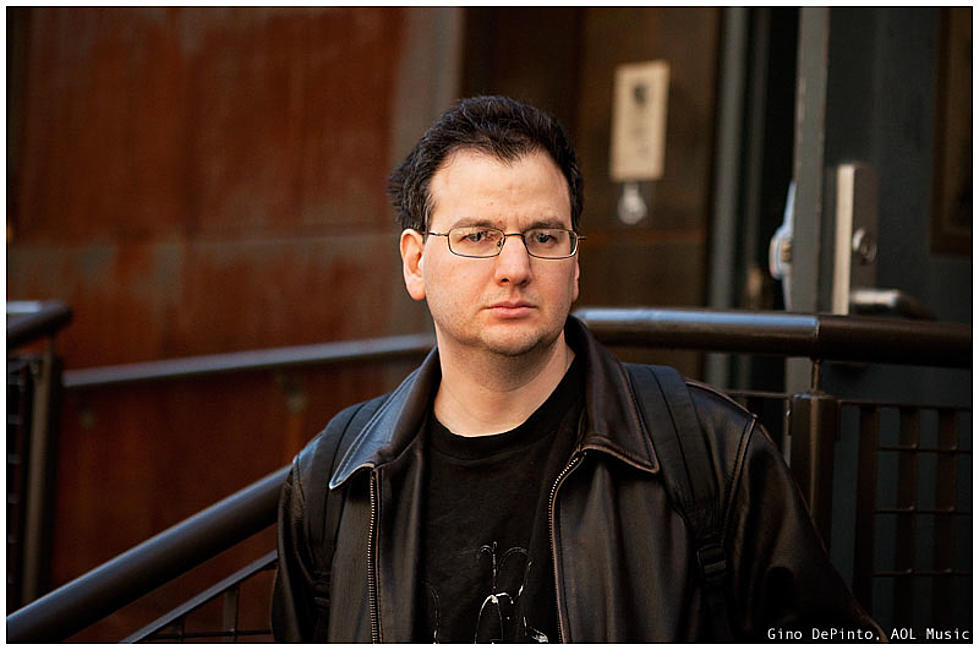Brian Tatler Discusses Diamond Head's Resurgence

In the late Seventies, Stourbridge, England, quartet Diamond Head were celebrated by the British press as a part of the New Wave of British Heavy Metal scene, which included Iron Maiden, Saxon and a very young Def Leppard. But magazine articles didn’t translate to instant acclaim.
“It was an exciting time, but it was also frustrating,” says Diamond Head guitarist Brian Tatler. “We watched these other bands get signed and kept thinking we were next, but it didn’t happen.”
Unable to land a significant record deal, the band self-financed its 1980 debut, Lightning to the Nations, and released it on Happy Face Records, a tiny label launched by the owner of the studio where they recorded. Then, Diamond Head placed an advertisement in the back of the British weekly Sounds and sold copies of the record for £3.50 via mail order.
When he saw the ad, a Danish-born teenager in Los Angeles, eager to soak up all the European metal he could find, ordered the album, which lived up to his every expectation. Lightning to the Nations was rife with palm-muted riffs, multiple rhythms and tempo changes and angry yet clear melodies that caused the kid’s pulse to race. He wrote gushing letters to Diamond Head’s fan club, then bought a plane ticket to London to see the group play the Odeon Woolwich in July 1981.
That uber-fan was Lars Ulrich, who had yet to form Metallica. After the gig, Ulrich snuck backstage and introduced himself to the members of Diamond Head.
“We were just talking, and Lars said he’d love to hang out with us for a while but he had had no place to live,” recalls guitarist Brian Tatler. “He basically invited himself, so he stayed on the floor in a sleeping bag at my parents’ house, where I was living. Then he went over to [ex–Diamond Head singer] Sean Harris’ house and slept on his couch for three or four weeks.”
Ulrich watched Diamond Head rehearse, hung out when they wrote songs and traveled with them to gigs. “He never said he was a drummer who wanted to form a band,” Tatler says. “He was just this crazy fan, but we were impressed with his enthusiasm. He was so full of beans that he was fun to be around. And the whole time he was there he watched us and soaked in the Diamond Head experience.”
Get The Pick Newsletter
All the latest guitar news, interviews, lessons, reviews, deals and more, direct to your inbox!
Thus began a symbiotic relationship between Ulrich and Diamond Head. Not long after Metallica started playing live, they fleshed out their set with five Diamond Head songs, “Am I Evil,” “The Prince,” “Helpless,” “It’s Electric” and “Sucking My Love.” And the band’s influence clearly rubbed off on some of the guitar parts on Metallica’s 1983 debut Kill ’Em All.
Fast forward 33 years, and Diamond Head are about to release their self-titled seventh album, which could trigger a long-awaited comeback. After a few shaky decades spent experimenting with prog and alt-metal, Diamond Head have returned to the sound that put them on the map and inspired Metallica to seek and destroy.
“The whole process of making this record was really fun and exciting,” Tatler says. “When we were writing we just plugged in and started playing stuff and waited for magic to happen, and occasionally it did. Somebody would come up with a riff or a change that would spin what we were doing in another dimension somehow. It would just take off.”
Diamond Head’s excitement strongly reflects in their songwriting, which pulls from classic NWOBHM without sounding like a retread. “Bones” begins with an ascending riff that segues into a crystalline arpeggio before bursting into a propulsive, bluesy passage, “Blood on My Hands” features a riff that sounds like a hybrid of early Deep Purple and Judas Priest and the closing song “Silence” incorporates mystical acoustic guitars, winding electric licks and orchestration that resembles Led Zeppelin’s “Kashmir.”
Tatler credits Diamond Head’s brand new singer, Rasmus Bom Anderson, with enabling the group to move forward by stepping backward. “I enjoyed hearing him sing the old songs so much that I thought maybe we should try to see if we could write some new songs that had that same energy,” Tatler says. “We all agreed it should capture what we liked about Diamond Head before we got sidetracked a little bit.”
Actually, it was more like a derailment. After the band released its first album it signed a deal with major label MCA and recorded 1982’s storming, musically complex Borrowed Time. But for its third record, 1983’s Canterbury, Diamond Head became far more progressive. NWOBHM fans lost interest, MCA dropped the band and Diamond Head broke up.
Over the next five years, Metallica paid back any debt they had to their mentors with interest. In 1984, they recorded “Am I Evil” as the b-side to “Creeping Death”; in 1987 “Helpless” appeared on The $5.98 E.P.: Garage Days Re-Revisited; and in 1988 “The Prince” was the b-side of the “Harvester of Sorrow” and “One” single.
“After we lost our record deal there was no money left,” Tatler says. “Then in 1990 we were offered a publishing deal and the chance to record together and tour. And a lot of that was based on the fact that Metallica was so big and Lars was constantly namedropping us. So it seemed daft not to get back together.”
The Diamond Head reunion shows were well-received, especially a 1993 gig opening for Metallica at the Milton Keynes Bowl in Buckinghamshire, England. But Diamond Head’s ho-hum 1994 album Death and Progress sold poorly, and fights between Tatler and vocalist Sean Harris caused another split. Again, Metallica came to the rescue. “Am I Evil,” “Helpless” and “The Prince” were included on the band’s 1998 quintuple Platinum covers album Garage Inc.
“I don’t know what I’d have done without the money I made from the Metallica covers,” Tatler says. “It kept me going and allowed me to not have a day job. But it repays their debt in a way as well. The bands that they liked and have been influenced by benefited from the covers they did. And they’re wearing their influences on their sleeves, and not trying to hide it, so it was good for everyone.”
Two years after Garage Inc. came out, Diamond Head tried to return to the music scene, but by then they were viewed as a nostalgia act. When the lackluster Death and Progress failed to captivate, Harris left the band. He was replaced in 2004 by Nick Tart, who sang on two more largely ignored records. Then in 2008, Tart moved to Brisbane, making it too difficult for him to record.
“We paid to fly Nick backward and forward for gigs, but it became increasingly stressful and expensive,” Tatler says. “So in March 2014 we decided to start looking for a singer that lived here in the U.K.”
That’s when Anderson came in and breathed new life into Diamond Head. As a devout NWOBHM fan, he was ecstatic to work with the band on new material and his enthusiasm was contagious. The band wrote new material from January to June 2015 and in an effort to recapture the energy of their first two albums, they returned to the age-old practice of getting together in a room every Sunday and jamming for eight hours, taping everything they came up with. During the week between jams, Tatler constructed songs by assembling complimentary passages. It was a refreshing change from showing up to rehearsal with complete tunes for the band to play or exchanging files over the internet, both of which Diamond Head had tried over their past three records.
“I wasn’t keen on the way that went,” Tatler says. “I’ve always felt that if a song sounds good in the rehearsal room with just three or four instruments it’s going to sound good live and it’s going to sound good on the record.”
Tatler wrote most of Diamond Head on his ’79 Standard Les Paul, and rhythm guitarist Andy “Abbz” Abberley, who joined the band in 2006, played a ’78 Custom Les Paul. There were multiple moments when Diamond Head captured lightning (to the nations) in a bottle. However, the sessions were hardly one flash of brilliance after another. And at the outset, the band fell into a rut and suffered from writer’s block.
Then, bassist Eddie “Chaos” Moohan wrote a chorus for a verse and bridge Tatler had written for “Bones,” and the floodgates opened.
“Everything suddenly shifted,” Tatler says. “We came up with one good idea after another. We were so excited we were jumping up and down like kids.”
When Diamond Head finished writing, they practiced the material over nine full-day rehearsals. Then in July 2015 they entered Vigo Studio near Birmingham, England and self-produced the album in about 25 days over a four-month period. “It’s not an expensive studio so we didn’t feel pressure to get it done quickly,” Tatler says.
With Diamond Head behind him, Tatler feels like his band is finally set up for a serious comeback, with new songs that are as strong as the material fans keep returning to see. “I really feel like this is the album fans have wanted to hear from us for a long time,” he concludes. “In another world, this would have been the record after Borrowed Time.”
Jon is an author, journalist, and podcaster who recently wrote and hosted the first 12-episode season of the acclaimed Backstaged: The Devil in Metal, an exclusive from Diversion Podcasts/iHeart. He is also the primary author of the popular Louder Than Hell: The Definitive Oral History of Metal and the sole author of Raising Hell: Backstage Tales From the Lives of Metal Legends. In addition, he co-wrote I'm the Man: The Story of That Guy From Anthrax (with Scott Ian), Ministry: The Lost Gospels According to Al Jourgensen (with Al Jourgensen), and My Riot: Agnostic Front, Grit, Guts & Glory (with Roger Miret). Wiederhorn has worked on staff as an associate editor for Rolling Stone, Executive Editor of Guitar Magazine, and senior writer for MTV News. His work has also appeared in Spin, Entertainment Weekly, Yahoo.com, Revolver, Inked, Loudwire.com and other publications and websites.



![[from left] George Harrison with his Gretsch Country Gentleman, Norman Harris of Norman's Rare Guitars holds a gold-top Les Paul, John Fogerty with his legendary 1969 Rickenbacker](https://cdn.mos.cms.futurecdn.net/TuH3nuhn9etqjdn5sy4ntW.jpg)







